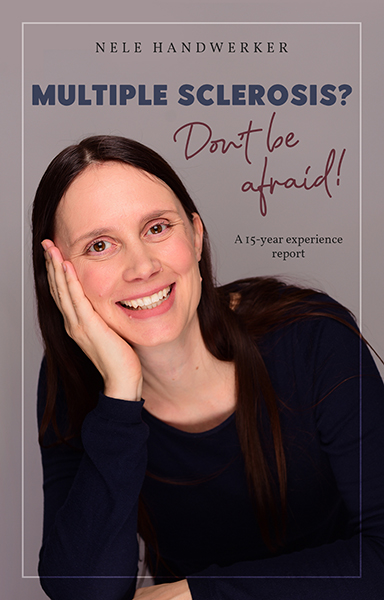This time it’s about nerve pain caused directly by multiple sclerosis and indirect pain caused by irritated pain receptors. Find out more about the causes and possible approaches to combat them. Hopefully, with so many options for treatments, you’ll find a suitable solution for yourself.
If you don’t have any problems with pain yet, the information can be helpful for later, as a preventative measure. Then you can react more quickly if it does affect you.
Klicken Sie auf den unteren Button, um den Podcast zu laden.
Table of Contents
When does MS-related pain occur?
They can already occur at the beginning of the disease. If MS remains active, whether noticeable or hidden, the likelihood of developing pain as a symptom increases steadily. Over the years, more than 80% of all those affected suffer at least temporarily from pain triggered by MS.
What types of MS-related pain exist?
Neuropathic pain is a direct consequence of an MS lesion and is caused by inflamed or damaged nerves. There are both attacks of pain and persistent pain. Sometimes the pain is part of an attack and subsides over time. The intensity varies greatly from patient to patient.
Indirect pain is triggered, for example, by muscle pain due to spasticity, incorrect posture, but also side effects of therapies, such as pain in the limbs. Depending on the trigger, the pain receptors are irritated in a specific area or entire areas of the body.
This ranges from the legs to the back and neck to the arms. Your body tries to warn you of damage to muscles, skin, tissue and bones. This makes sense in principle, so take the signals seriously, get to the bottom of them and try to eliminate or reduce the cause as best you can.
No matter what type of pain it is, if it occurs frequently or is permanent, you should do something about it. Because pain reduces your enjoyment of life.
What exactly is a pain diary and how can it help you?
Everyone feels pain differently and it can have a variety of causes. Successful treatment therefore requires a detailed examination of the causes. You can support your treating neurologist by keeping a pain diary.
Make a note of as many details as possible:
- Whether the pain is pressing, burning, pulling, dull or electrifying.
- Note the exact location of the pain.
- Note when the pain occurs with the date and time and how long it lasts.
- What intensity it had on a scale from 1 to 10.
- The doctor also needs to know if certain situations trigger, worsen or improve the pain.
- If you have taken medication for it, it is important to know whether it helped or not and what dose you took.
- If you want to record more information, please feel free to do so.
You can keep a pain diary in written form or digitally using an app. The important thing is that your neurologist receives the entries so that they can get a better picture.
How can you deal with MS-related pain?
Please take pain seriously instead of bearing it. Frequent or even permanent pain reduces your quality of life and performance. It may lead to permanent restrictions and, if it persists for a long time, it can also become chronic.
Take action and contact your neurologist directly if you have nerve pain. For indirect pain, you can weigh up the options. You can either speak to your neurologist about occupational therapy, physiotherapy, aids or medication. Or you can try out various active options to get rid of the pain. In any case, don’t wait too long.
Nerve pain
If you have nerve pain, you should consult your neurologist. Classic examples are eye movement pain in acute optic neuritis. When you move your eyes, many sufferers experience stabbing pain.
The Lhermitte’s sign sends electric shocks from your neck to your arms and legs when you bring your chin to your chest. Even if it is only unpleasant for you, but in principle new, your neurologist should know about it.
Dyesthetic pain can cause a constant burning sensation, the feeling of ants running over your body or needle-like pain. It mainly occurs in the legs and feet. Arms and hands can also be affected. They usually make themselves felt at night or are triggered by physical exertion.
Trigeminal neuralgia can lead to intense pain in the eyes, scalp, nose, jaw, forehead and the side of the face. It can be triggered by normal activities such as brushing your teeth, chewing or speaking.
Indirect pain
Pain in the musculoskeletal system and joints responds very well to physiotherapy. You are welcome to supplement the therapy with thermal treatments and anti-inflammatory medication.
If you suffer from spasms, you will find soothing stretching exercises in yoga. They can help you to relax your tense muscles.
Iyengar yoga is also particularly suitable for poor posture, as it works with many aids and allows you to train side by side and address the different strengths and weaknesses of each side of your body.
You can treat aching limbs caused by interferon therapy with an anti-inflammatory medication such as paracetamol or ibuprofen. However, you should always speak to your doctor first to discuss the frequency and dose, as they are best placed to deal with possible interactions.
How can physiotherapy and occupational therapy help?
Physiotherapy
Physiotherapy offers many support services under its two pillars, exercise therapy and physical therapy.
In movement therapy, there are a lot of exercises that can help you to relieve your pain. If you are shown exercises that are particularly good for you, make a note of them so that you can do them yourself at home.
Physical therapy includes treatments with heat and cold as well as massages. Find out what is good for you and relieves your pain. In any case, cramped and stiff muscles can be loosened up well.
You may have to try a few things before you find the right one for you. Don’t get frustrated and keep at it so that you soon have less or, if possible, no more pain.
Occupational therapy
Occupational therapists can help you with non-specific pain in particular. They use exercises and aids to train damaged nerves. So if you suffer from pins and needles and burning pain or it feels like ants are running over your body, try occupational therapy.
How can supportive devices reduce MS-related pain?
They can improve your posture and support cramped and stiff muscles. Seek advice from a specialist.
If you are already using aids, these may need to be readjusted or optimized. As there are a huge number of aids available, I will not go into detail here. Your neurologist and your therapists are the people to contact.
What can you do yourself to combat MS-related pain?
Have you ever tried acupuncture and acupressure? They are one way of relieving pain and muscle spasms. Sometimes one appointment is enough, often several sessions are necessary. Acupuncture has helped me several times with pain that was not related to MS.
There are lots of relaxation techniques that can help you regain your inner balance and do something good for your body at the same time. These include progressive muscle relaxation according to Jacobsen, Feldenkrais, meditation, Tai Chi and Qigong. Of course, there are many more.
Remember that pain can put you in a permanent state of tension, which only exacerbates the problem. You can counteract this with relaxation techniques.
A lesser-known technique is eutony. It attempts to balance out tension in the body and maintain and improve your mobility. The aim of the exercises is to harmonize breathing, blood and lymph circulation, muscle and connective tissue tone and metabolism.
Sport is, of course, an effective remedy for pain. You get your entire circulation going and release happiness hormones.
Check with your local patient organization to see if there are any offers that suit you. They often offer relaxation techniques and exercise classes, either digitally or in person.
What medication is available for MS-related pain?
First of all, you should be aware that complex causes of pain require individualized treatments. This may mean that your neurologist will have to try a few things before success is achieved. Hang in there and aim to get rid of the pain completely or at least reduce it significantly.
Your neurologist has several groups of medication to choose from. These include antidepressants, antiepileptics, antispasmodics and opioids or non-steroidal anti-inflammatory drugs. Based on your overall condition and taking into account other medications, they will suggest something suitable and adjust it if necessary.
And what if nothing helps?
If you suffer from massive attacks of pain in the trigeminal nerve, surgery can provide relief. However, it should really be the last choice and you should have tried all other options thoroughly beforehand.
What is the best prevention against MS-related pain?
The best thing to do is to become an expert in your disease. Then you can work with your neurologist to see how you can best slow down MS. This includes an effective disease-modifying medication, which stops or massively slows down the noticeable and hidden disease activity. Other components are a healthy lifestyle and physical and mental training. And not forgetting a stable psyche, keyword resilience.
For pain, as for all other MS symptoms, the longer MS progresses unchecked, the greater the risk of new and permanent impairments. And cortisone is only a relapse therapy, it does not change the long-term course of the disease. So take advantage of the knowledge and opportunities to lead a beautiful and fulfilling life with MS.
Food for thought
Stay as active as possible and take part in social life. By focusing on the positive and beautiful, you leave less room for pain. Because the more you feel into your pain and focus on it, the fewer distractions you allow your body. And distraction gives your mind the signal that the pain is not your main focus. That’s good. Of course, this only works if the pain is reasonably bearable. I’ll keep my fingers crossed that you find the right balance between actively doing something about the pain and not focusing on it completely.
Question for you
Have you ever had pain associated with MS?
Maybe thse articles could be interesting for you as well:
- #022: Exploring exercise’s immune benefits and MS symptom relief: Prof. Ulrik Dalgas shares insights
- #042: Movement restrictions in MS – how to maintain your strength, balance and mobility in the best possible way
- #047: Spasticity in MS – far more than normal muscle cramps
- #037: Nourand – Unlocking the Nutritional Code for MS with Dr. Mireia Sospedra
See you soon and try to make the best out of your life,
Nele
For more information and positive thoughts, subscribe to my newsletter for free.
Click here for an overview of all podcast episodes published so far.

And at many more places.
* This text contains affiliate links. This means that I get a small compensation if you buy the product recommended by me through the link. For you nothing changes in the price of the product. And it helps me to pay for the blog and to write new posts.










